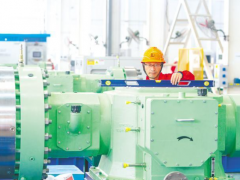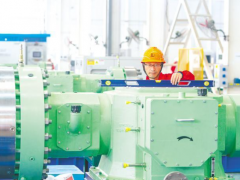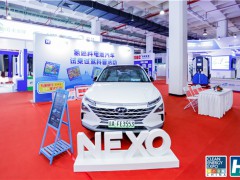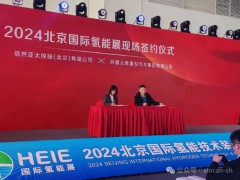美国莱斯大学的科学家们发明了一种将氨转化为氢的新方法
这项研究遵循政府和行业投资,为不会导致温室效应的无碳液氨燃料创建基础设施和市场
氨气仍然是相当有害的气体,但它的点火和快速燃烧是可以忽略不计的
据油价网报道,美国莱斯大学(Rice University)的科学家们日前发明了一种光活化催化剂,可以只使用廉价的原材料就能有效地将氨气转化为清洁燃烧的氢气。这个设计是一种光激活纳米材料,可将氨气转化为清洁燃烧的氢气。
这项工作是莱斯大学纳米光子学实验室、Syzygy等离子体子学公司和普林斯顿大学Andlinger能源与环境中心的一个合作项目。该研究报告已发表在《科学》杂志上。
在这项研究启动之前,美国政府和行业投资建立了基础设施和市场,以生产不会导致温室效应的无碳液态氨燃料。液态氨易于运输,每个分子含有1个氮原子和3个氢原子,能量巨大。新的催化剂将这些分子分解成氢气(一种清洁的燃料)和氮气(地球大气中最大的成分)。与传统催化剂不同的是,它不需要热量。相反,它从光中收集能量,无论是阳光还是节能的LED。
化学反应的速度通常随着温度的升高而加快,一个多世纪以来,化学品生产商一直在利用这一点,在工业规模上加热。燃烧化石燃料将大型反应容器的温度提高数百或数千度会产生巨大的碳足迹。化学品生产商每年还在热催化剂上花费数十亿美元,这种材料不发生反应,但在强烈加热下会加速反应。
这项研究的合著者、莱斯大学的内奥米·哈拉斯指出:“像铁这样的过渡金属通常是较差的热催化剂,这项工作表明它们可以成为高效的等离子体光催化剂。这也证明了光催化可以用廉价的LED光子源有效地进行。”
莱斯大学研究报告的合著者彼得·诺德兰德补充说:“这一发现为可持续的、低成本的氢气铺平了道路,这种氢气可以在当地生产,而不是在大型集中式工厂生产。”
最好的热催化剂是由铂和相关贵金属如钯、铑和钌制成的。 哈拉斯和诺德兰德花了数年时间开发光激活或等离子体金属纳米颗粒。 其中最好的也通常是由银和金等贵金属制成的。
2011年,他们发现了等离子体粒子,这种粒子会释放出短命的高能电子,称为“热载流子”。2016年,他们发现热载流子发电机可以与催化粒子结合,产生混合“天线反应器”,其中一部分从光中收集能量,另一部分利用能量以外科手术般的精度驱动化学反应。
哈拉斯、诺德兰德、他们的学生和合作者多年来一直致力于为天线反应器的能量收集部分和反应加速部分寻找非贵金属替代品。这项新研究是这项工作的高潮。在这篇文章中,哈拉斯、诺德伦德、莱斯大学校友侯赛因· 罗巴塔兹、普林斯顿大学工程师兼物理化学家艾米丽·卡特等人展示了由铜和铁制成的天线反应器粒子在转化氨气方面非常高效。粒子的铜能量收集部分从可见光中获取能量。
Robatjazi是哈拉斯研究小组的博士校友,现在是总部位于休斯敦的光催化剂研发公司Syzygy Plasmonics的首席科学家,他解释说,在没有光的情况下,铜-铁催化剂表现出比铜-钌催化剂低300倍的反应活性,这并不奇怪,因为钌是一种反应更好的热催化剂。在光照下,铜-铁的效率和反应活性与铜-钌的效率和反应活性相似并具有可比性。
Syzygy Plasmonics公司已经获得了莱斯大学的天线反应器技术的许可,该研究还包括在该公司的商用LED动力反应器中对催化剂进行大规模测试。在莱斯大学的实验室测试中,用激光照亮了铜铁催化剂。Syzygy Plasmonics公司的测试表明,催化剂在LED照明和比实验室设置大500倍的规模下仍然保持其效率。
哈拉斯说:“这是科学文献中第一份表明LED光催化可以从氨气中产生克级数量的氢气的报告。”“这为完全取代等离子体光催化中的贵金属打开了大门。”
卡特补充说:“鉴于等离子体天线反应器光催化剂在显著减少化学部门碳排放方面的潜力,它们值得进一步研究。”“这些结果是一个很好的激励因素。他们认为,充足的金属的其他组合很可能被用作广泛化学反应的低成本催化剂。”
有人可能会认为,氢气运输和储存解决方案的大门很快就会打开。对于大多数人来说,氢气作为运输燃料,便携性和安全性更高。
氨气仍然是相当有害的气体,但它的点火和快速燃烧可以忽略不计。氨气也是氢气的非加压载体。氨气确实有一种非常强烈的气味。总而言之,作为一种实用的氢气载体,它是相当不错的。
还有一些问题,比如需要多少光能来驱动一辆汽车。扩大测试正在进行中。然后,人们会想知道如何消除氮气,以及以某种方式将氮气或双氮分子排放回大气中是否会造成能源成本。
李峻 编译自 油价网
原文如下:
Scientist Invent New Way To Convert Ammonia Into Hydrogen
· Rice University scientists have invented a new way to convert ammonia into hydrogen.
· The research follows government and industry investment to create infrastructure and markets for carbon-free liquid ammonia fuel that will not contribute to greenhouse warming.
· Ammonia is still fairly noxious, but its ignition and rapid combustion are negligible
Rice University scientists have invented a light-activated catalyst that efficiently converts ammonia into clean-burning hydrogen using only inexpensive raw materials. The design is a light-activated nanomaterial to convert the ammonia into clean-burning hydrogen fuel.
The effort is a collaborative project from Rice’s Laboratory for Nanophotonics, Syzygy Plasmonics Inc. and Princeton University’s Andlinger Center for Energy and the Environment. The research report has been published in the journal Science.
The research follows government and industry investment to create infrastructure and markets for carbon-free liquid ammonia fuel that will not contribute to greenhouse warming. Liquid ammonia is easy to transport and packs a lot of energy, with one nitrogen and three hydrogen atoms per molecule. The new catalyst breaks those molecules into hydrogen gas, a clean-burning fuel, and nitrogen gas, the largest component of Earth’s atmosphere. And unlike traditional catalysts, it doesn’t require heat. Instead, it harvests energy from light, either sunlight or energy-stingy LEDs.
The pace of chemical reactions typically increases with temperature, and chemical producers have capitalized on this for more than a century by applying heat on an industrial scale. The burning of fossil fuels to raise the temperature of large reaction vessels by hundreds or thousands of degrees results in an enormous carbon footprint. Chemical producers also spend billions of dollars each year on thermocatalysts – materials that don’t react but further speed reactions under intense heating.
Study co-author Naomi Halas of Rice noted, “Transition metals like iron are typically poor thermocatalysts, This work shows they can be efficient plasmonic photocatalysts. It also demonstrates that photocatalysis can be efficiently performed with inexpensive LED photon sources.”
Rice co-author Peter Nordlander added, “This discovery paves the way for sustainable, low-cost hydrogen that could be produced locally rather than in massive centralized plants.”
The best thermocatalysts are made from platinum and related precious metals like palladium, rhodium and ruthenium. Halas and Nordlander spent years developing light-activated, or plasmonic, metal nanoparticles. The best of these are also typically made with precious metals like silver and gold.
Following their 2011 discovery of plasmonic particles that give off short-lived, high-energy electrons called “hot carriers,” they discovered in 2016 that hot-carrier generators could be married with catalytic particles to produce hybrid “antenna-reactors,” where one part harvested energy from light and the other part used the energy to drive chemical reactions with surgical precision.
Halas, Nordlander, their students and collaborators have worked for years to find non-precious metal alternatives for both the energy-harvesting and reaction-speeding halves of antenna reactors. The new study is a culmination of that work. In it, Halas, Nordlander, Rice alumnus Hossein Robatjazi, Princeton engineer and physical chemist Emily Carter, and others show that antenna-reactor particles made of copper and iron are highly efficient at converting ammonia. The copper, energy-harvesting piece of the particles captures energy from visible light.
Robatjazi, a Ph.D. alumnus from Halas’ research group who is now chief scientist at Houston-based Syzygy Plasmonics explained, “In the absence of light, the copper-iron catalyst exhibited about 300 times lower reactivity than copper-ruthenium catalysts, which is not surprising given that ruthenium is a better thermocatalyst for this reaction. Under illumination, the copper-iron showed efficiencies and reactivities that were similar to and comparable with those of copper-ruthenium.
Syzygy has licensed Rice’s antenna-reactor technology, and the study included scaled-up tests of the catalyst in the company’s commercially available, LED-powered reactors. In laboratory tests at Rice, the copper-iron catalysts had been illuminated with lasers. The Syzygy tests showed the catalysts retained their efficiency under LED illumination and at a scale 500 times larger than lab setup.
“This is the first report in the scientific literature to show that photocatalysis with LEDs can produce gram-scale quantities of hydrogen gas from ammonia,” Halas said. “This opens the door to entirely replace precious metals in plasmonic photocatalysis.”
“Given their potential for significantly reducing chemical sector carbon emissions, plasmonic antenna-reactor photocatalysts are worthy of further study,” Carter added. “These results are a great motivator. They suggest it is likely that other combinations of abundant metals could be used as cost-effective catalysts for a wide range of chemical reactions.”
One might think the door could be open soon for the hydrogen transport and storage solution. For most folks looking at hydrogen for a transport fuel, portability, and lots more safety, ammonia containment offers a huge leap forward.
Ammonia is still fairly noxious, but its ignition and rapid combustion are negligible. It is also a non pressurized carrier for hydrogen. It does have a very strong odor, giving some warning of its escape. All in all, as a practical hydrogen carrier, its pretty good.
There are some questions like just how much light energy is needed to say, power an automobile. The scale up testing is underway. Then one wonders how to dispense with the nitrogen and if there is an energy cost as well to venting somehow a N2 or di-nitrogen molecule back into the atmosphere harmlessly.
We’re going to be watching for more on this.
免责声明:本网转载自其它媒体的文章及图片,目的在于弘扬石化精神,传递更多石化信息,宣传国家石化产业政策,展示国家石化产业形象,参与国际石化产业舆论竞争,提高国际石化产业话语权,并不代表本网赞同其观点和对其真实性负责,在此我们谨向原作者和原媒体致以崇高敬意。如果您认为本站文章及图片侵犯了您的版权,请与我们联系,我们将第一时间删除。







